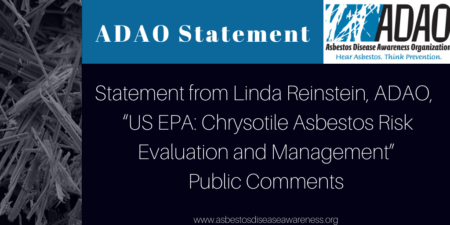Posted on February 3, 2021
The statement below is from Linda Reinstein, co-founder and president of The Asbestos Disease Awareness Organization (ADAO), the nation’s largest independent nonprofit asbestos victims’ organization in the United States, in regard to the Environmental Protection Agency (EPA) hosting a public webinar, “US EPA: Chrysotile Asbestos Risk Evaluation and Management,” on February 3, 2021.
 “The Trump Administration’s EPA released a Final Risk Evaluation for Asbestos, Part 1: Chrysotile Asbestos on December 30, 2020. It concludes that six current asbestos uses present unreasonable risks to health. As EPA moves into risk management, it should ban these six uses under the Toxic Substances Control Act (TSCA). More limited measures would be ineffective and unprotective in light of the absence of a safe level of exposure for asbestos and the alarmingly high toll it continues to take on the lives and health of Americans.
“The Trump Administration’s EPA released a Final Risk Evaluation for Asbestos, Part 1: Chrysotile Asbestos on December 30, 2020. It concludes that six current asbestos uses present unreasonable risks to health. As EPA moves into risk management, it should ban these six uses under the Toxic Substances Control Act (TSCA). More limited measures would be ineffective and unprotective in light of the absence of a safe level of exposure for asbestos and the alarmingly high toll it continues to take on the lives and health of Americans.
“Asbestos is a known carcinogen that kills nearly 40,000 Americans annually and represents one of the largest preventable health threats that our population faces. In contrast to nearly 70 other countries, the U.S. has not banned asbestos and its importation and use remain largely unrestricted. It is beyond time for EPA to not only own up to the Agency’s prior mistakes, but to fix them once and for all by eliminating asbestos uses it has found present an unreasonable risk.
“Despite its findings of unreasonable risk for the six uses, the final evaluation has gaping holes and addresses only one fiber type, two of the many diseases linked to asbestos, and only limited conditions of use. It also fails to account for all pathways of exposure that increase risk to public health and safety. As a result, the evaluation greatly understates the true risk that asbestos poses to Americans.
“EPA’s own independent Science Advisory Committee on Chemicals (SACC) agreed with the concerns raised by ADAO and public health experts in its review of the draft evaluation, concluding that: ‘Overall, EPA’s environmental and human health risk evaluation for asbestos was not considered adequate and resulted in low confidence in the conclusions.’
“Notably, the evaluation does not include one of the biggest pathways of exposure — the legacy asbestos found in our air, soil, and water as well as in millions of homes, schools, and office buildings nationwide. Meaningful evaluation of asbestos risk is impossible without accounting for pervasive exposure to legacy asbestos across the US.
“EPA has said that it will undertake a future ‘Part 2’ evaluation focused on legacy asbestos but has provided no specifics about how it would be conducted, and failed to set a schedule for completing it. Part 2 must also fix the flaws in Part 1, but we have no commitment that Part 2 would achieve this goal. As we wait for clarity on Part 2, more people risk exposure and death.
“Asbestos, especially legacy asbestos, puts all Americans at risk, but some communities are more vulnerable than others. Asbestos factories, such as the one in Davidson, North Carolina, built around a low income community of color, put already underserved residents at increased risk of exposure. These communities are unable to clean and abate the asbestos themselves, and frequently lack access to good medical care and legal justice — an example of environmental racism, and a human rights violation we can not allow to continue.
“Today a new administration has the opportunity to right these wrongs once and for all. The time to act, and protect Americans from the scourge of asbestos, is now.
“Joining me in making oral comments on February 3 are Bob Sussman, Dr. Barry Castleman, and Brent Kynoch.”
###
